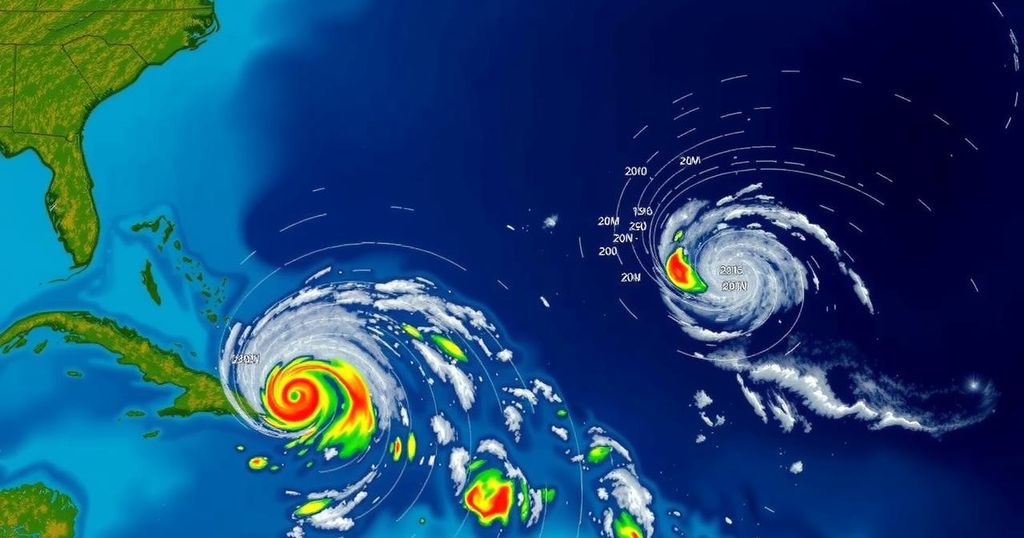Hurricane Season to Reawaken in Its Final Month

The final month of the hurricane season features three areas of concern in the Atlantic, particularly in the western Caribbean, with the potential for a tropical depression to form. While the Gulf Coast might receive some atmospheric protection, heavy rainfall and possible flooding are expected in parts of Central America and Mexico’s Yucatán Peninsula. Although November usually sees fewer storms, this season is already above average for activity, suggesting the possibility of continued tropical threats.
The hurricane season, although it finds itself in its concluding month, is not without its impending threats. As November unfolds, three significant areas within the Atlantic basin warrant close observation due to indications of potential tropical development. One such area situated in the western Caribbean demonstrates a high probability of evolving into a tropical depression by late this weekend or early next week, as per insights from the National Hurricane Center. Upon formation, there exists the possibility for this system to escalate into a tropical storm, with naming conventions dictating that the next storm will be referred to as Patty, succeeded by Rafael and Sara. Current predictions lack precision regarding the forthcoming storm’s trajectory, though there is a likelihood of it drifting towards the Gulf of Mexico. In the interim, the western Caribbean, alongside parts of Central America and Mexico’s Yucatán Peninsula, may face heavy rainfall and gusty winds by the following week. Furthermore, the Gulf Coast may be poised for some atmospheric shielding next week after enduring numerous devastating hurricanes during this season. Predicted upper-level winds could mitigate any storm making its way into the Gulf, potentially dissipating its strength. While two additional regions within the Atlantic showcase low chances for tropical development, recent stormy weather, which has caused record-breaking rainfall in Puerto Rico, may offer a slim opportunity to coalesce into a tropical system as it progresses westward. However, even in the absence of development, further flooding could adversely impact Puerto Rico, the Virgin Islands, and Hispaniola throughout the weekend and into next week. The remaining identified area of interest in the open Atlantic remains unlikely to endanger land. Historically, the hurricane season draws to a close in November; however, this year departs from the norm, exhibiting above-average figures in named storms, hurricanes, and major hurricanes classified as Category 3 or stronger. Despite a lull in activity during a traditionally busy season, the US has experienced the impact of five hurricanes. While November typically sees fewer storms, it is noteworthy that conditions this year suggest the trend of activity will persist. Statistically speaking, while thirty-eight named storms have formed in November since the late 1800s, most landfall events occur before this month according to hurricane expert Michael Lowry. Tropical storms that do form in November usually develop in areas where warm water temperatures are sustained longer and where wind patterns are less disruptive, particularly in the Caribbean and central Atlantic. The Gulf of Mexico, typically a source of minimal tropical activity in November due to strengthening winds, still holds warmer-than-average waters. As such, the Caribbean may remain a focal point for tropical systems as November progresses towards its later half.
The Atlantic hurricane season typically experiences its peak period from August to October, but November can also produce significant storms, although they tend to occur less frequently. Understanding the development of tropical storms and hurricanes in this late phase of the season is critical due to the potential for unpredictability and unusually heightened activity, as evidenced in 2023. On average, many systems have been recorded as forming in the Atlantic, occasionally causing notable impacts on coastal regions, particularly in the Gulf of Mexico.
In summary, while the hurricane season typically draws to a close in November, this year exhibits an unusual pattern with several areas in the Atlantic basin showing potential for tropical development. Despite a record of previous hurricanes impacting the US coastline, the upcoming weeks may still portend additional storms. Given warmer-than-average water temperatures and favorable atmospheric conditions, the Caribbean remains a significant area to monitor for tropical activity in the waning days of the hurricane season.
Original Source: www.cnn.com






